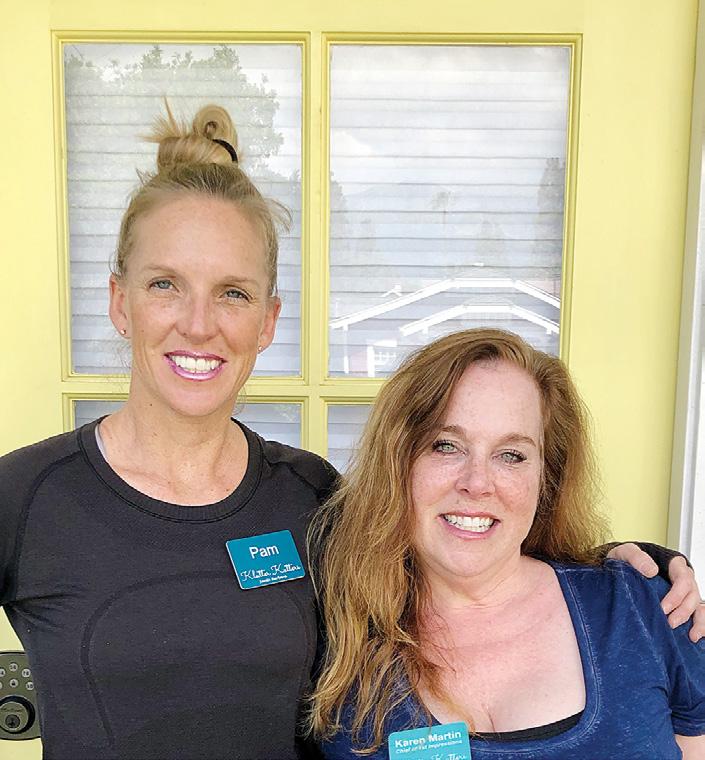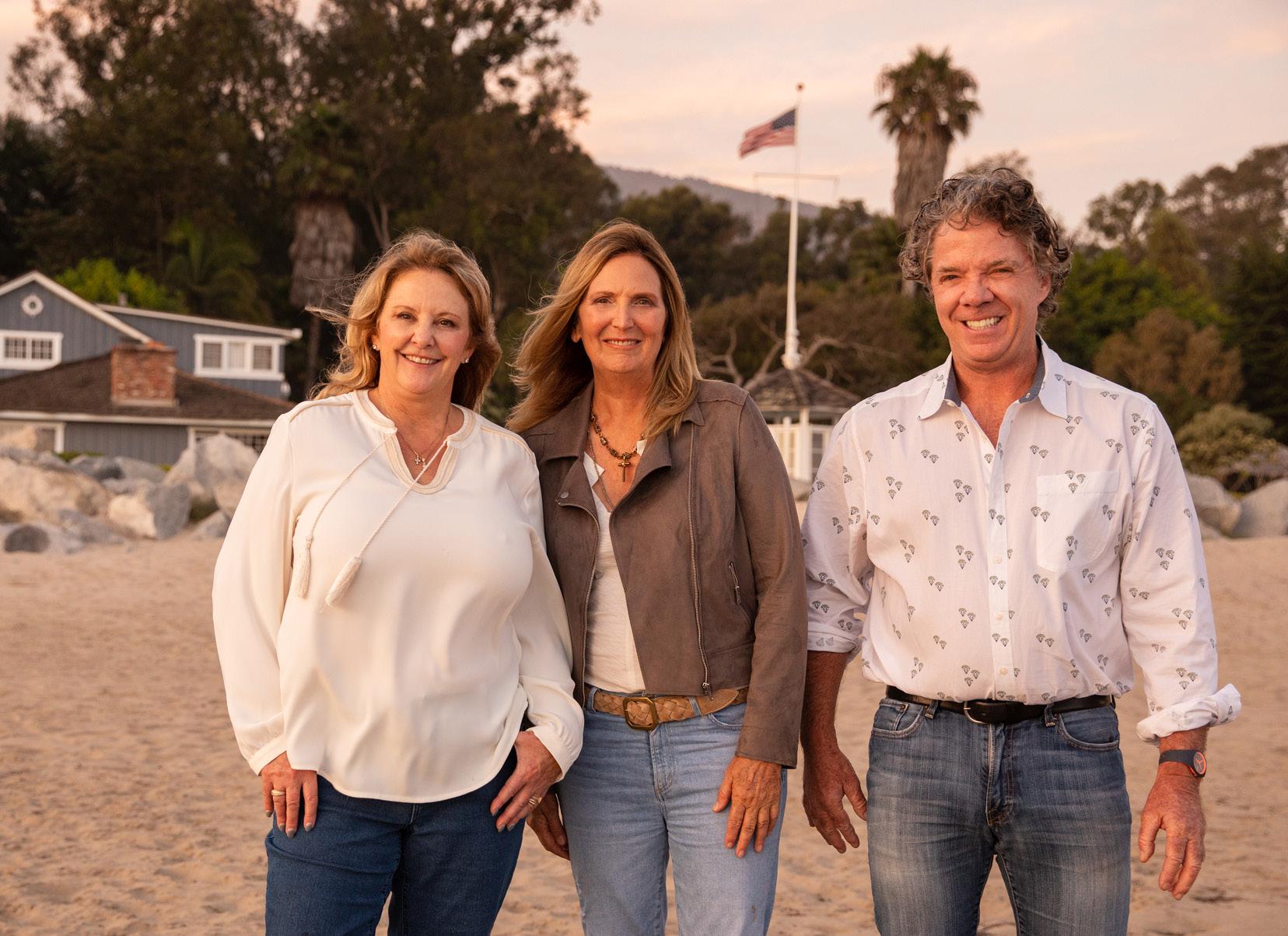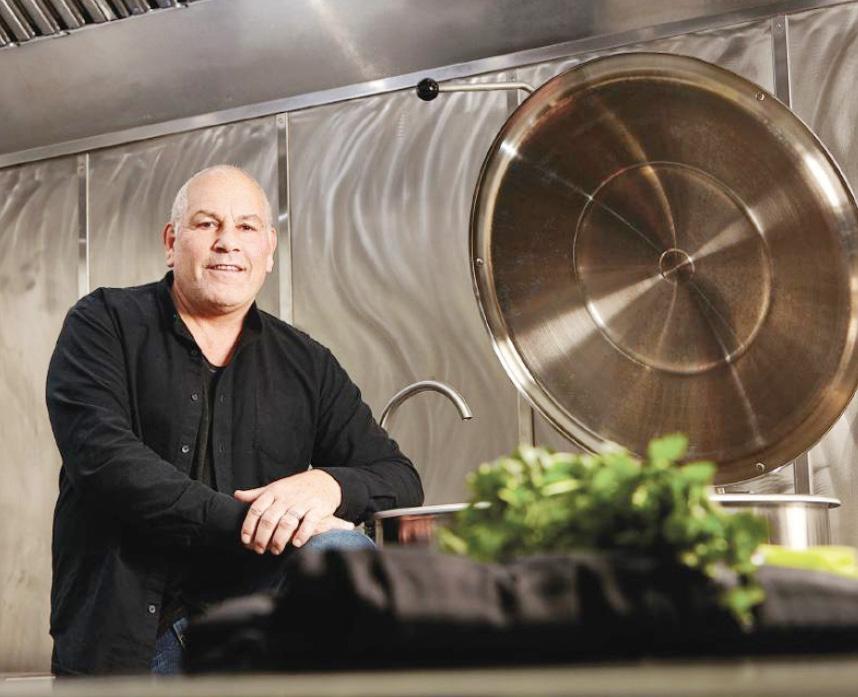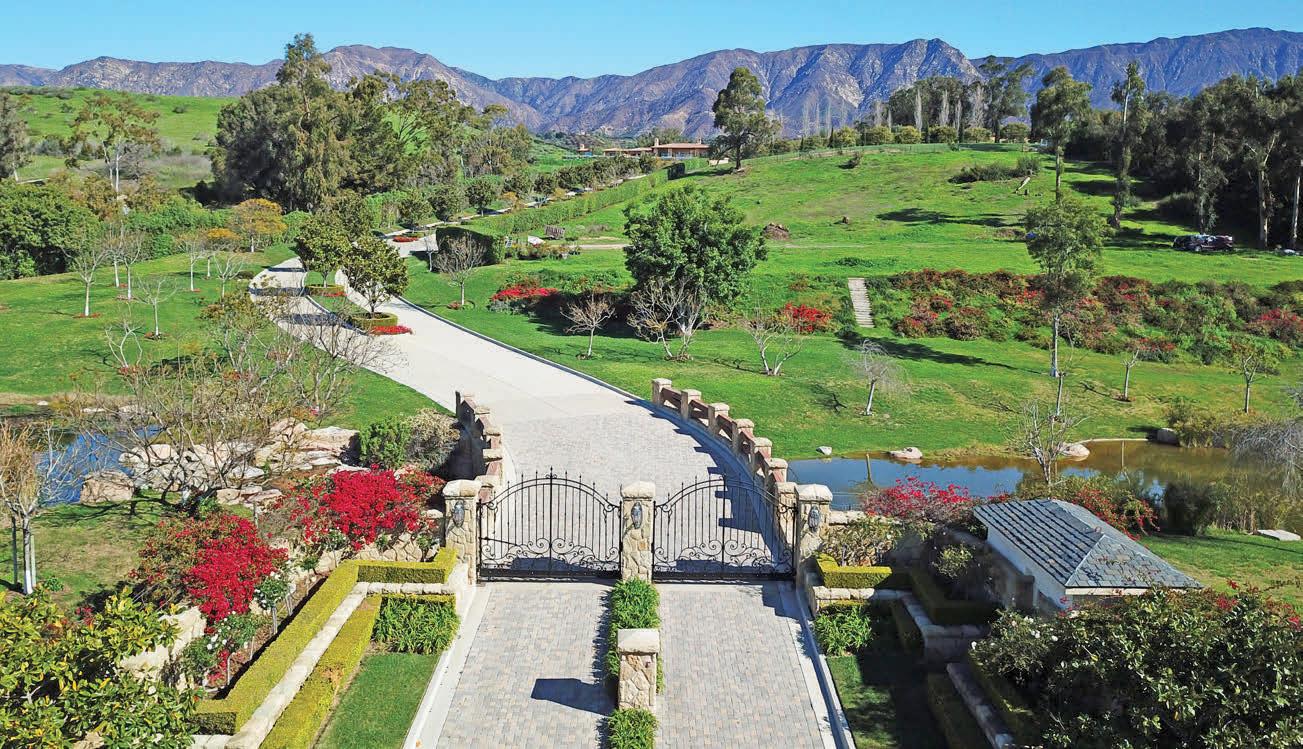
28 minute read
three billion birds
Accessing an Alternative to Anxiety “Spirituality Matters” highlights two or three Santa Barbara area spiritual gatherings. Unusual themes and events with that something extra, especially newer ones looking for a boost in attendance, receive special attention. For consideration for inclusion in this column, email slibowitz@yahoo.com.
Sheng Zhen meditation creates a deep state of inner peace
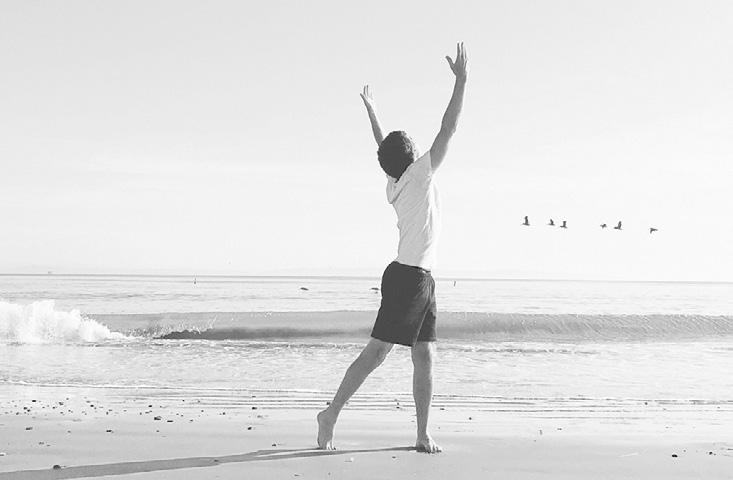
“S heng Zhen means unconditional love in Chinese, and its purpose is to produce that within ourselves,” said Bryce Lupoli. “What that means practically is that Sheng Zhen helps us live with a quiet mind, a relaxed and healthy body, and an open heart.”
Lupoli is one of only a few local teachers of the practice comprised of gentle, graceful, and healing movements and contemplations that stimulate the body’s life force energy (qi), producing a deep sense of inner-peace and well-being. Lupoli, who has been studying and more recently leading Sheng Zhen in town only since 2018, started reading about ancient wisdom at 16, when he was struck by existential depression. For the following eight years he unsuccessfully tried to use philosophy to think his way out of depression before spending five weeks in an ashram where he discovered the benefits of meditation.
“Meditation fundamentally changed my life,” explained Lupoli, who talks in a slow, measured pace that in itself evokes calmness. “I was depressed for seven years, two of which I was suicidal. I thought I was a foundationally sad person. But through meditation, I discovered my depression was a product of attaching my sense of self to my personal story and my thoughts. When I detached from the stories, my mind was quiet, and love, meaning, joy, and peace automatically came flooding in.”
Seeking a movement practice that could help integrate the stillness of his meditation practice into much more dynamic everyday life and also heal a serious auto-immune disease that had resulted in joint pain, Lupoli came across Sheng Zhen, and was instantly drawn to the practice that combines Qi Gong-style moving and non-moving meditation. He immediately attended a 36-day Sheng Zhen retreat with the practice’s founder, Master Li Junfeng, who had previously achieved international fame as a popular film actor, action director and the coach of the Beijing Wushu team. Soon after, Lupoli started teaching, with a desire to spread the practice to his friends, family and community.
“Sheng Zhen is the most accessible meditation I’ve ever come across,” Lupoli explained, adding that the aspect makes it perfect for those who are suffering but think they can’t sit still or quiet their minds. “The body acts as a portal – when it relaxes, the mind is able to relax into a state of quietude. We do the rhythmic, smooth motions and then pause in still meditation, and the quietude remains.”
Sheng Zhen differs from Qi Gong or Tai Chi because it teaches that to move well is a good thing, to feel chi in the body is also good, but not so important as to live with love and peace, Lupoli said. “Master Li – who comes from China and has extensive experience in Qi Gong – told me that those practices are wonderful but sometimes the teachers never speak about or seek to embody love, even though the mastery of any arts or practice inevitably results in love.”
Lupoli recently returned to town and started teaching Sheng Zhen regularly at Yoga Soup and other locations around town. Then the situation with the coronavirus intensified. He decided to both broaden the practice and make it available online to help alleviate the high level of anxiety, sleeplessness and even panic many people are experiencing in dealing with or imagining the extent of the crisis.
“Sheng Zhen is a specific, proven means for gathering perspective and peace and strength and love within oneself, and thereby becoming a seed for those qualities that can spread to one’s family and community,” he noted. “I wanted to bring it to the community, because we are social creatures who derive strength and encouragement from being around each other. Meeting with others who value and embody peace and loving-kindness helps these qualities bloom within us, too.”
Santa Barbara locals can practice together with the sun, ocean, wind, and sand as a backdrop in person at Lookout Park (aka Summerland Beach) from 5:15-6:15 pm on Fridays, and 10-11 am on Sundays, beginning this week. For those who are unable to attend in person, or want to stay sheltered at home, he’s also offering half-hour sessions every day save for Fridays, either at 5 pm or 10 am on the video conferencing platform Zoom (https://us04web.zoom. us/j/4927511554). All of the classes are free.
Lupoli also encourages those who have a more formal practice such as prayer, deep breathing, yoga, or a different form of meditation to get deeper as the days grow darker.
“I encourage people to find whatever their practice is, and make a commitment to do it, and with the community. It’s not about a specific practice, but a way of being.”
(For more information about Sheng Zhen, visit https://shengzhen.org. For Meetup details, visit https:// www.meetup.com/Sheng-ZhenMeditation-of-Santa-Barbara.) Bryce Lupoli leads in-person and virtual Sheng Zhen practices
Salt Cave Staying Open Salt, which bills itself as the largest underground crystal salt cave in North America, is not ready to close its cave nor its doors, as the boutique features pink Himalayan salt in crystal cave rooms, massage and facial treatments, and unique products made in Santa Barbara for the home, body, and cooking. “We’re still open and everything is still happening,” said Chava Logan, general manager of Salt Cave which has graced downtown Santa Barbara since 2012. Cave sessions, however, are limited to just 10 people per hourly session to maintain mandated social distancing, and Logan explained that the salt air is pumped in, and that the stuff salt is both antibacterial and antiviral.
Salt is also keeping its workshops going, although a few of the teachers have called in cancellations. Sunday’s Yin Yoga, Chakra Meditation & Sound Healing session, led by Susan Rae, works to open up a potent meditative awareness of breath, deep listening, and witnessing of sensations through longer, passive holds. The workshop uses ancient healing techniques to create a deeper connection between consciousness and the spiritual realms. The 9:30-10:30 am session is followed later in the afternoon by a 4:30-5:30 pm Sound Healing Experience with Phil Schwartz. On Monday, March 23, a Slow Flow with Sound Healing workshop from Christine Fronterotta aims to have participants enjoy mindful, conscious breath and movement, as physical postures become fused with inspired teaching to create a soulful motion. Singing bowls and other healing instruments are played for a longer Savasana, to offer vibrations of restoration and healing via sound waves, and aid in meditative practice for the 5:30-6:30 pm session.
Soup’s Off at Downtown Studio
“In fourteen years Yoga Soup never closed its doors, not once,” owner Eddie Ellner wrote in an email and note late on Monday, noting that the studio has stayed open “through fires, storms, slides, illness, locusts, bad hair days, insurrection.” The impetus was to take the line by poet Robert Frost to heart: “Home is the place where, when you have to go there, they have to take you in… But our mandate to serve the Santa Barbara community perversely demands we do just that.”
Ellner stressed that Yoga Soup wasn’t taking the action lightly.
“It’s during unnerving times that Yoga Soup has felt most useful in
MONTECITO JOURNAL34 “You do not find the happy life. You make it.” –Camilla Eyring Kimball SPIRITUALITY (Continued from page 33) being open. As a studio devoted to providing safe harbor, to challenging fear-based beliefs and panic-driven decision-making, shutting down feels both dangerously counter intuitive and the right necessary action to take… If the only way to contain this virus was for a totalitarian country to lockdown 100 million of its people – and then for three of the world’s most free-spirited democracies to follow suit – then we’d better pay attention.” So there won’t be any classes or workshops at the space that offers more of both than any other location in town at least through the coronavirus crisis. On the other hand, the lobby and store will remain open, at least for now, where people can pick up such items as immune-building supplements, healthy packaged food, alcohol-based sprays exceeding virus-killing recommendations, daily self-care tools, yoga props and meditation cushions for home practice, plus musical and massage instruments for extended home stays and books, perhaps the “perfect home companion” – but no fresh soup, carrots, or oatmeal – Ellner said. “Books that remind us that we’ve been through this before, books that remind us we will be okay, books that remind us of who we are. Books that inspire us.”
The good news is that the studio has geared up for an Internet presence, with an invitation to collectively practice at Yoga Soup Online (https:// clients.mindbodyonline.com/launch). All of the studio’s dedicated teachers will start posting online classes this week if they haven’t already. The studio is collecting and recording classes (15-60 minutes long) from its teachers and became available on Wednesday (March 18). The recorded class library will continue to grow. To attend one of the pre-recorded classes, go to Yoga Soup on the Mindbody app and click on the “Online Classes” tab.
In addition to pre-recorded classes, Yoga Soup will start offering one to two live stream classes daily on Thursday, March 19, so the community can practice in real time with their favorite teachers. Those will take place on Zoom, and students will have to have the Mindbody app connected to a Yoga Soup account. Yoga Soup will send a link to the live class to those signed up five minutes before. Students can use regular memberships or class packs to attend the live classes online.
Ellner also stressed that online membership will help keep the studio in business, so Yoga Soup has come up with three options. Those who pay the full membership rate will receive 10 class passes for friends after re-opening. A special reduced online membership ($65) results in five class passes. Or people can use already purchased class pack to take individual pre-recorded or live classes online, or buy a drop-in single online class for $7. Those who prefer to have membership paused should contact luca@yogasoup.com.
Still, Ellner hadn’t lost his whimsical sense of humor, adding, “We’re also working hard on a virtual equivalent to oatmeal, soup, and sweet potatoes.” Downtime to set up streaming at DiviniTree
DiviniTree Yoga went one step further to make “the conscious choice” to temporarily close its physical studio and switch to offering classes online. “This was the most challenging and gut-wrenching decision I’ve ever had to make as a small business owner,” wrote owner Jill Agonias. “I know for a fact that yoga and this supportive community has literally saved people’s lives. This practice saved my life. Maybe it’s even saved yours… On the other hand, this decision has actually become quite obvious (because) there are many, many people in our greater communities about whom we need to be mindful may be more compromised and vulnerable (than we are). It’s for these people that we need to work together to slow the spread. It’s these lives that need to be saved now.” As at Yoga Soup, DiviniTree is making its classes available to everyone online, although the studio promises that all of them will be streamed live via Zoom, following the same procedures with the MindBody app. The studio plans to host two live classes every day through March 31, one in the morning or at lunch and the other in the evening, each 35-45 minutes long. Everyone will have access to live classes while studio members will enjoy exclusive access to all recorded classes as the library builds. Each class will have a 100-person capacity. Check www.divinitreesantabarbara. com/schedule. Unlimited access will cost $68 per month, while single virtual classes are available for $12 each. DiviniTree will also offer one free Instagram class per week through “Instagram Stories.” Follow Divinitree Santa Barbara on Instagram (www. instagram.com/divinitree.santabar bara) for updates. Power-Ful Practice Still Taking Place
Power of Your Om, located upstairs at 1221 State Street down the hall from SOhO, is still maintaining its full schedule as of Monday night. The only adjustment is in reducing the capacity from 49 to 20, and also offering live streaming of some of the classes for home practice as well. Sunday’s upcoming Yoga Nidra workshop is also still registering. The 5:30-7:30 pm event taught by Tricia Speidel addresses stress – certainly an issue that’s pertinent to the times – through restorative yoga postures, yoga nidra, and stress-relieving essential oils in service of turning down the intensity of stress and tuning into a new state of consciousness. Yoga nidra or “yogic sleep” is a state of consciousness between waking and sleeping, like the “going-to-sleep” stage, in which the body is completely relaxed as the practitioner becomes systematically and increasingly aware of the inner world by following a guided meditation. Attendees are advised to wear comfortable, snuggly clothes, bring a yoga mat, blanket and anything else you would like to be as comfortable as possible for a long savasana. And, of course, maintain six feet of “social distance.” Admission is $40. Weininger Winds Her Way to the Web Radhule Weininger is cancelling in-person meetings to help stop the spread of the virus, but instead of scaling back, the veteran meditation teacher is upping the ante and actually adding meetings to its slate of online offerings. So the Zoom schedule now includes Mondays at 7 pm with Weininger, Tuesdays at 7 pm with Stacy Zumbroigel, Wednesdays at 7 pm with Danjo San joining Weininger, Thursdays at 2 pm with Juliet Rohde-Brown, Thursdays at 7 pm with Renee Golan, and Sunday mornings at 10 am (starting March 29) with Weininger and her husband, palliative care physician and writer Michael Kearney. The meetings will take place over Zoom at https://zoom. us/j/5612731921 and will sandwich check-ins and chatting before and after the meditation sessions to enhance the feeling of togetherness. Admission is free. Bodhi Path in Cyberspace
Bodhi Path Santa Barbara has announced that it wants to help minimize the spread of COVID-19 while still providing support to the sangha and community by moving all programs to online platforms until further notice. All programs may be accessed at their regularly scheduled times via Zoom links. Tuesday night sangha-led meditations take place 6-7 pm at https://zoom.us/j/582915912. Part 2 of “Awakening Bodhicitta – How to Open Your Heart and Develop Love and Compassion” from resident teacher Dawa Tarchin Phillips, takes place 7-9 pm Thursday, March 19, at https://zoom.us/j/746-572-464.
Phillips will also teach “Buddha Nature: Uncovering the Sacred Within” on March 21-22, from 10 am to 4 pm both days, during which he will address “Our True, or Awakened Nature – Buddha – a timeless subject of scientific exploration, philosophical examination and spiritual contemplation.” The class will explore and discover how awakened nature works, and why following a path to awakening with sincerity and commitment is the most effective way of reducing suffering, and accessing potential for happiness and freedom. The fee is $250, with scholarships available. Register at: http://groupspaces.com/ BodhiPathOnline/item/1244935.
Meanwhile, the Mahakankala Buddhist Center has announced that it is closing through the end of March, and perhaps longer, while investigating moving meditations and other sessions to streaming online.
Meetups Still Meeting Going to gatherings in the great outdoors appears to be safe as long as people maintain appropriate space for “social distancing.” So Ascension Academy will still be hosting Kundalini Yoga to Balance the Chakra System and Restore Inner Peace from 10 to 11 am every Saturday at the Mission Rose Garden (420 Plaza Rubio), where the Kundalini Yoga sessions focus on the balance of a new chakra each class using the techniques of the potent ancient technology (free admission), and Meditation & Breathework Practice for Beginners & All Levels 10-11:30 am every Sunday at Lower Manning Park - Area 9, in Montecito, where the group focuses on learning the basic techniques of meditation and breathwork as well as its benefits, and how to incorporate meditation and its techniques into daily life ($10-20 suggested donation). Visit www.meetup.com/ Santa-Barbara-Kundalini-Yoga-andMeditation-Meetup-Group.
Closing Time
Among the spiritual centers choosing to close at least through the end of the month is Sunburst Sanctuary and Retreat Center, although the Lompoc center’s spiritual director and office staff are available by phone and email at (805) 736-6528 or contactus@sunburst.org for those seeking support. Meanwhile, Unity of Santa Barbara’s Sunday services have migrated to the Internet through at least the end of March. The 10 am live stream can be accessed at www.santabarbaraunity. org. A podcast (audio only) from last Sunday’s service, which featured Rev. Cathy Norman’s message and meditation plus Dr. Jim Kwako providing his medical perspective on the coronavirus, is available at www.santabar baraunity.org/podcast. •MJ
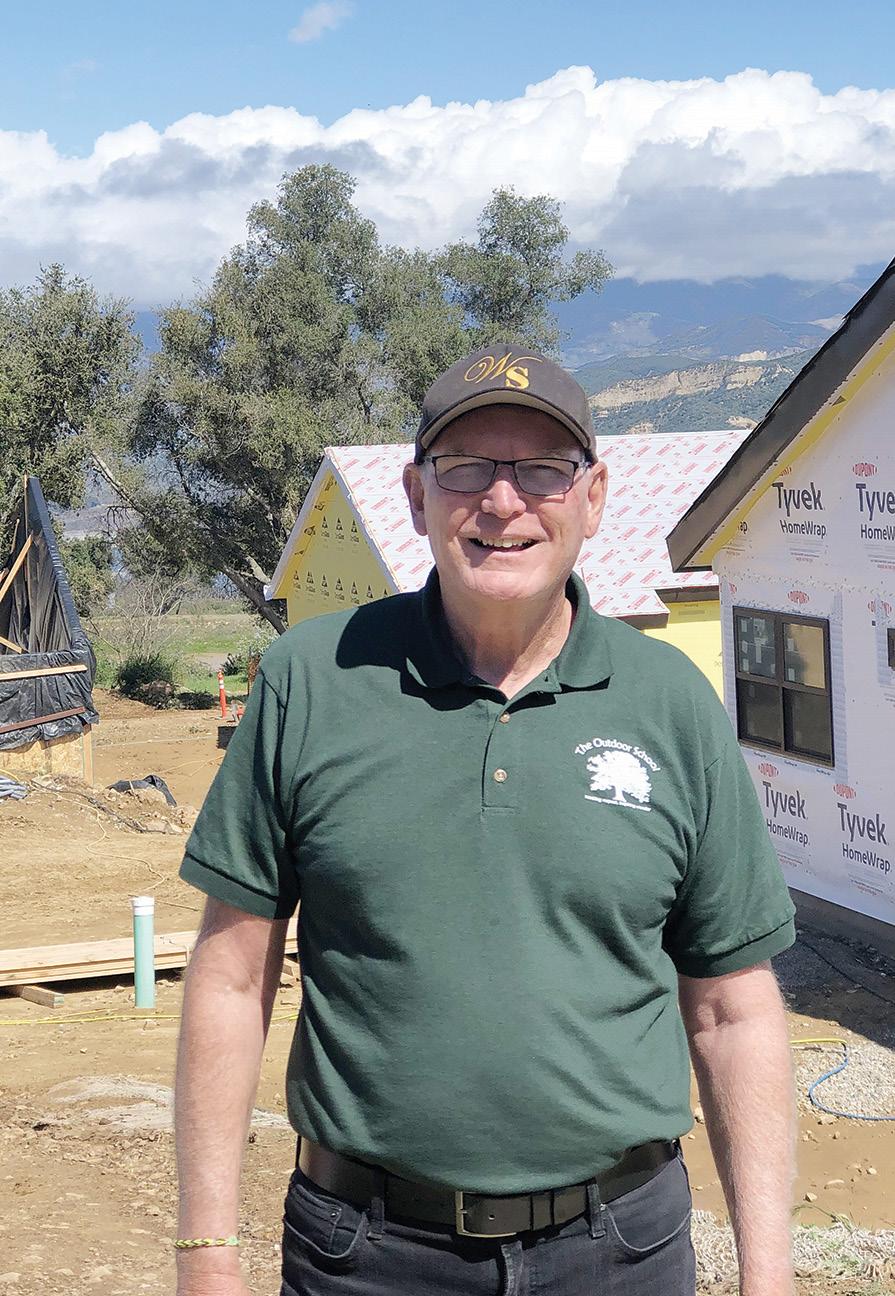


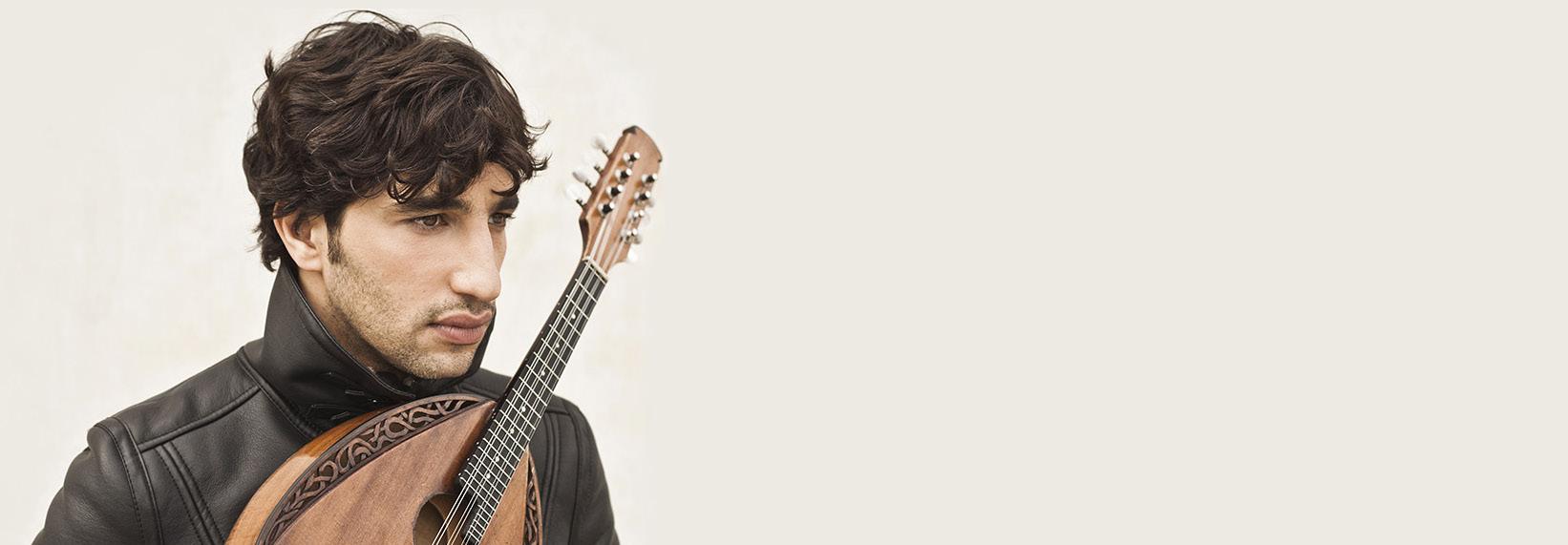
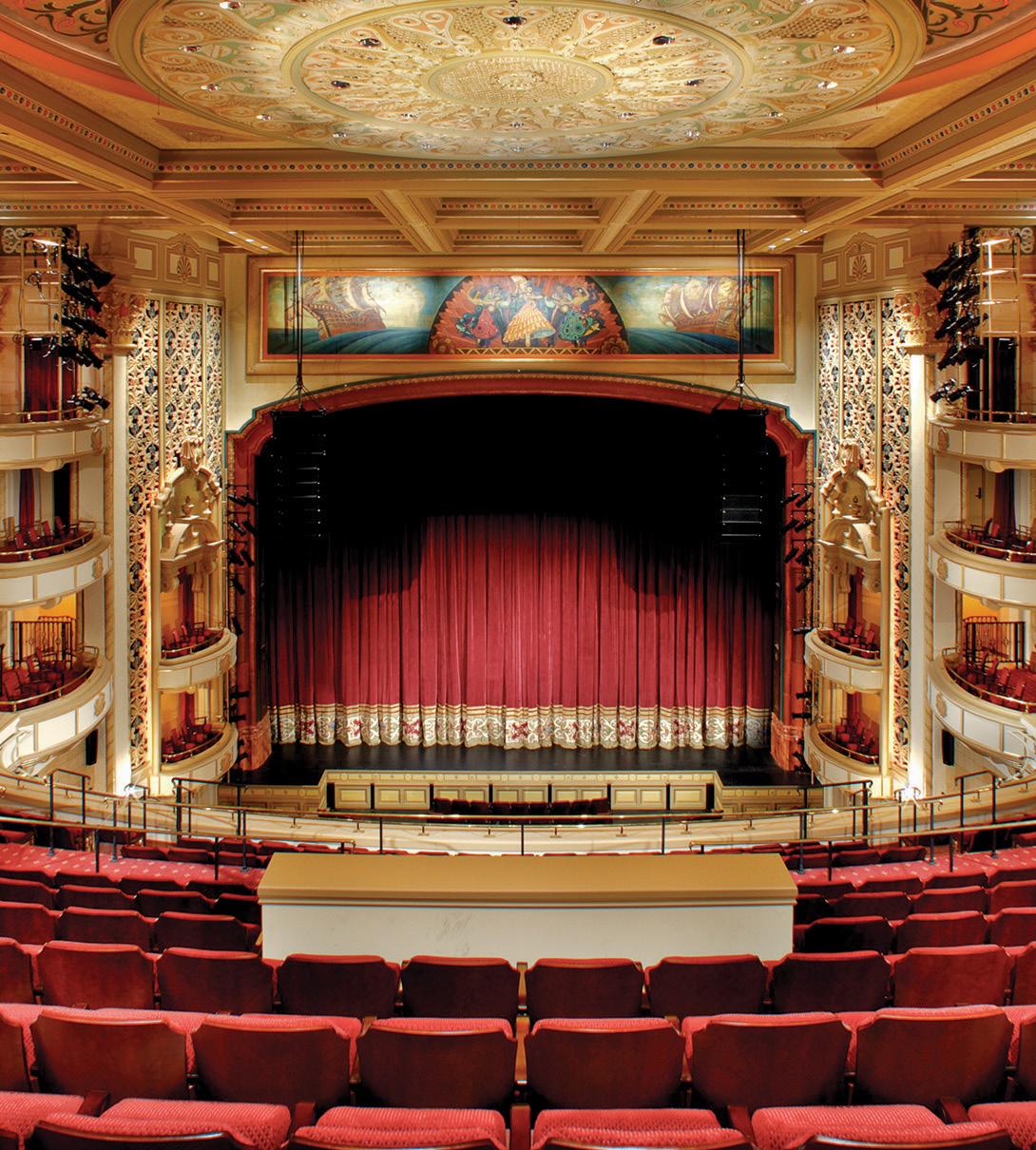
• The Voice of the Village • 19 – 26 March 2020 MONTECITO JOURNAL 35 805.899.2222 GranadaSB.org 1214 State Street, Santa Barbara Donor parking provided by Thank you to our Season Title Sponsor ALL PERFORMANCES THROUGH MARCH 31 HAVE BEEN POSTPONED OR CANCELED. We are working closely with our resident companies and other presenting organizations to reschedule where possible. If you hold tickets to a canceled or rescheduled performance in the month of March, please visit GranadaSB.org/Covid-Form Elizabeth Smart - March 28 Presented by CALM Auxiliary Sleeping Beauty - March 14 Presented by State Street Ballet Sealed - March 19 Presented by Network Medical Rotterdam Philharmonic Orchestra - March 26 Presented by CAMA Lyon Opera Ballet - April 1 & 2 Presented by UCSB Arts & Lectures An American in Paris - March 21 & 22 Presented by Santa Barbara Symphony AFFECTED PERFORMANCES CAMA presents LES VIOLONS DU ROY Tue APR 28 8pm UCSB Arts & Lectures presents GAUTIER CAPUÇON & YUJA WANG Mon APR 27 7pm Goldenvoice presents ROB LOWE STORIES I ONLY TELL MY FRIENDS: LIVE! Sat APR 25 8pm VILLAGE BEAT (Continued from page 25) 50-year-old camp, which is located off the San Marcos Pass, had served 10,000 students and their families each year. In addition to hosting camps for the Los Padres Boy Scouts, church retreats, and community gatherings, Rancho Alegre was the site of The Outdoor School, serving school districts in Santa Barbara County, San Luis Obispo County, Ventura County, and beyond. Ken Miles, Development Director for the Boy Scouts of America Los Padres Council, gave us a tour of the property last week. The Whittier Fire of July 2017 destroyed 215 acres of wooded camp including 47 of the camps 50 structures; the dining hall and cafeteria, one dorm, and one cabin were spared. Since the fire, volunteers have been meeting weekly, determined to rebuild. Debris has been cleared, plans have been made, and construction has begun, as evidenced last week. Trey Pinner, property owner on Coast Village Road and president of the Los Padres Council, took over the presidency following the fire, although he has been involved with the scouting program for the last 18 years. “We see this rebuilding as an opportunity to take the camp and Outdoor School program to a significantly new level,” Pinner said. “The facilities that we are building are significantly improved and will have greater longevity than the buildings that were lost.”
The Outdoor School, which is a program of the BSA Los Padres Council, is a unique overnight environmental education program and one of the driving factors behind the push to rebuild Rancho Alegre. In this outdoor learning environment, fifth and sixth graders explore beyond classroom walls and are immersed in handson outdoor environmental educational activities, hiking and exploring nature, opening doors to self-discovery, learning new skills and forging friendships that last a lifetime. Camp counselors and naturalists who run the camp often go on to careers in geology, biology, and science, inspired by their time at camp.
Rebuilding costs for Phase 1 of the project are estimated at $17.5 million, with $9 million coming from insurance coverage. Because the infrastructure was outdated, much of the insurance money is being used to rebuild the water and sewage system, as well as a solar system to provide electricity. “We are now reaching out to the community to bridge the gap and ensure local schoolchildren will again have this opportunity to experience the outdoors at this unique local camp,” Miles said.
With the goal of opening in October 2020, crews have already made progress on buildings to house full time residents including the camp ranger, camp director, and chef. Four dorm buildings are also currently under construction, which will house up to 150 students and chaperones at a time. Housing for seasonal staff, which includes camp counselors, naturalists, nutritionists, and nurses, are also planned, with foundations poured and ready to build upon. All buildings are being built with foam core walls, concrete siding, and metal roofs, making them extremely fire resistant. “They are designed to be rented out to families during the summer, as an additional revenue source,” Miles said. Other infrastructure in the works include outhouses and campsites, a ropes course that can be utilized for emergency training purposes, and eventually a lodge, which will be built in the second phase of the project. The pool, which survived the fire, is being rehabilitated.
“We’re not asking people for money, we’re giving them the opportunity to do something good for somebody else,” Pinner said, adding that there have been significant donations from over two dozen entities and individuals, including the Berti Family and Jurkowitz Family, who are the largest contributors. “We hope that, once built, this facility will be the premier outdoor school facility for our community and beyond, and that potential donors can see the importance of this project,” Pinner said.
For more information on the Capital Campaign visit www.lpcbsa.org/ran cho-alegre-reconstruction/ or call Ken for information and a personal tour at 805-835-9456.
Donors’ names will be placed on the Wall of Gratitude at the camp, and there are multiple naming opportunities. “When you match a donor’s passion to the right cause, it can be life changing,” Miles said. “People really can make a difference.” •MJ Ken Miles with the Boy Scouts of America Los Padres Council is busy raising funds for the rebuilding of Rancho Alegre
So it sounds like, it’s not good enough, but better, in terms of testing and the log jam may be starting to break?
I would very much want to reassure our community that inside the hospital, testing is not a problem. We are getting tests for the patients who need tests. The biggest testing challenge is really for patients who are unwell and at home and understandably very much want an answer. One week ago, we had far more scarcity of testing for our community. Today we have far more tests. I’m optimistic that if we reevaluate this in one week or two weeks the story will be very different again.
Is there a message you want the community at large to know?
I most passionately want people to understand that the dramatic measures we’re taking with social distancing, with closures, postponements and turning people’s lives upside down, are being made to try to “flatten the curve” and to slow down the epidemic. When people hear that schools are closing it strikes fear in the heart of many parents. My feeling is actually the opposite. This is not a disease that we think significantly affects children, but we know that closing schools is a great way to decrease the spread of a disease. It’s not about the kids, it’s about the community’s health.
You had a line in the Cottage video: “We’ve only tested the snowflake on the tip of the iceberg.” The iceberg metaphor and visual was brilliant. Is there another analogy that’s helpful? We’ve heard people say it’s like World War II except we’re on the front lines. Do you have any other analogies, that help everyday people think about this?
The other one I’ve heard is that “it’s hard to address the infestation of the rats in the basement if you don’t turn the lights on in the basement and go downstairs.” I prefer to think of the snowflake on the top of the iceberg.
MONTECITO JOURNAL36 Is that because a big piece of that iceberg, the part we can’t see, is really people who are asymptomatic?
That’s exactly right and that’s probably because of the younger population and those who are less medically complex. If we’re only testing the snowflake or perhaps this week, we’re now testing the snowball on the tip of the iceberg, we don’t yet know the size of the epidemic. The vast majority of our population are going to get through this. Maybe half of all people who carry this virus don’t have symptoms. Eighty percent or more of people who fall ill have a mild upper respiratory infection. You have to remember that the reason we’re doing these efforts that upend our lives is for the good of our public health and that of our community.
How’s it going in terms of in the hospital infection, the nurses, the staff, and the doctors?
Hospital workers are perhaps our most precious resource in all of this. Cottage is working around the clock to improve our systems, to prepare in anticipation that this is going to affect our communities. In Santa Barbara we’re fortunate that at this point we’re not yet seeing a big increase in respiratory illness for our admitted patients. That said it changes every day. Every hour. There is some fear amongst healthcare workers about potentially being exposed, but we’re in a far better position than the core physicians and healthcare workers in China or in Italy. We have had time to plan and to get our systems in place to protect our healthcare workers. I think, some degree of anxiety is understandable.
There’s a lot of negative and even euphoric news in the social media world that seems unrealistic. What do you think about the future? Will things go back to normal. Does it run its course? Well, one of the challenges of the concept of “flattening the curve” is thinking ahead to how long we are talking. We know that our healthcare systems are going to be better off if we see a trickle of patients, as opposed to a surge of patients. But one of the interesting questions I was asked this week was, is there a point at which, this really takes too long to come through in a way that doesn’t disrupt our lives for months and months or longer? What we don’t know about the virus itself is how it’s going to behave in our human population in the long term. Is it going to be an epidemic that comes through and moves on, that we developed some immunity to as a population? Or is there some seasonality to this? Is it going to mutate and change in such a way that we’re at risk down the road? These are unanswered questions.
One big takeaway watching your video is the importance of hospitals. Why are hospitals so important? Why are hospitals a line of defense?
Well unfortunately some percentage of patients are falling so sick so quickly that they would not survive outside of the hospital, that they need care that can only be delivered in a hospital and often only in an ICU to save their life. While the percentage may not be very high, the number of patients may be very high. So, because there is no cure, no vaccine, and limited therapeutic options, it seems funny and obvious to say that comes down to that good old four-letter word, “care.”
I’ve spoken about Ebola in the video. That was another viral epidemic for which there was no known treatment. In the Democratic Republic of the Congo, the mortality rate was 90%. Nine out of every 10 people died. While in Western Europe and the United States, we had a total of 27 patients during that epidemic and only 18% of the patients who fell ill died. Now that’s still a tragedy. That’s still horrendous but the difference there between 18% in our healthcare system compared to 90% in the developing world is almost entirely because these patients had access to excellent hospital clinical care.
Which means they’re in a bed, in a controlled environment?
They’re getting IV fluids. If they need oxygen, they get oxygen. If they can’t breathe there’s a machine to help support their lungs. If they go into shock, they get medicines to help. If they get another infection on top, like a bacterial infection, they get antibiotics. These life saving measures make all the difference. This is all of the care that we provide in our healthcare system. That’s why hospitals are so important.
Then how do we support our hospitals and our healthcare workers?
Great question. We start by asking, what do people need? During this really unprecedented set of events that we’re living through, I think pausing and asking our neighbors, asking our nursing friends, what do you need? I think being thoughtful and careful, but really asking, asking around the community, where is the need this week? And being ready for that to change next week because this is a very, very fluid situation.
What about literally donating to hospitals? Contributions, masks, or these other items that we’ve heard nurses and doctors don’t have?
There’s certainly a need everywhere for PPE, personal protective equipment, but I think reaching out to organizations for what their needs are is definitely the place to start.
For Cottage Hospital there is a weblink https://www.cottagehealth.org/donate/.
That’s right, but there’s another thing I think will help. You know the Montecito Journal may have a readership with some large percentage older than the age of 65. And we’re asking people to do this social kind of isolation and self-quarantine. This can be very, very hard on people. The younger population has grown up with electronics and devices and really have a very different type of social connection from those who are over 65. So, I think there’s a really big opportunity for our seniors to lean in with their electronics and stay better connected to friends and loved ones. Simple things like FaceTiming, but there’s so many platforms that people can be connected to one another.
Perhaps it’s even about time that younger people help older people figure out how to use those devices and stay socially connected. Hopefully some youth organization might organize that. Well I hope we can stay in touch for updates as the situation changes.
Well, thanks. I’m glad we did this. •MJ
The best little paper in America (Covering the best little community anywhere!) Executive Editor/CEO Gwyn Lurie • Publisher/COO Timothy Lennon Buckley Editor At Large Kelly Mahan Herrick • News and Feature Editor Nicholas Schou Associate Editor Bob Hazard • Copy Editor Lily Buckley Harbin Arts and Entertainment Editor Steven Libowitz

Contributors Scott Craig, Julia Rodgers, Ashleigh Brilliant, Sigrid Toye, Zach Rosen, Kim Crail Gossip Richard Mineards • History Hattie Beresford • Humor Ernie Witham Our Town Joanne A. Calitri Society Lynda Millner • Travel Jerry Dunn • Sportsman Dr. John Burk • Trail Talk Lynn P. Kirst
Account Managers Sue Brooks, Tanis Nelson, Casey Champion Bookkeeping Diane Davidson, Christine Merrick • Proofreading Helen Buckley
Design/Production Trent Watanabe
Published by Montecito Journal Media Group, LLC PRINTED BY NPCP INC., SANTA BARBARA, CA Montecito Journal is compiled, compounded, calibrated, cogitated over, and coughed up every Wednesday by an exacting agglomeration of excitable (and often exemplary) expert edifiers at 1206 Coast Village Circle, Suite H, Montecito, CA 93108. How to reach us: Editorial: (805) 565-1860; Sue Brooks: ext. 4; Christine Merrick: ext. 3; Classified: ext. 3; FAX: (805) 969-6654; Letters to Editor: Montecito Journal, 1206 Coast Village Circle, Suite H, Montecito, CA 93108; E-MAIL: tim@montecitojournal.net
Your community. Your program. Your Arts & Lectures.
We are Santa Barbara. As a community we are curious, engaged and resilient. We have weathered storms before, and come together to lend a helping hand to our neighbors. It is who we are. But, in light of social distancing efforts, how can we make meaningful connections and foster vibrant cultural exchange?
While your options for inspiration and entertainment are in flux, Arts & Lectures is still here for you. We’re continuing onward, working to create new ways for us all to stay connected through digital arts and culture content. In this difficult time when we’re not seeing each other, we’ll be sharing some ideas that inspire us. Connect with us. Go to ArtsAndLectures.UCSB.edu and sign up for our email list to receive new content, clips from the A&L archive, and a curated selection of arts and ideas, all accessible online.







In the words of our good friend Pico Iyer, “Freedom seldom comes from changing our circumstances, and nearly always from changing the way we look at them.” With deepest appreciation, Arts & Lectures











